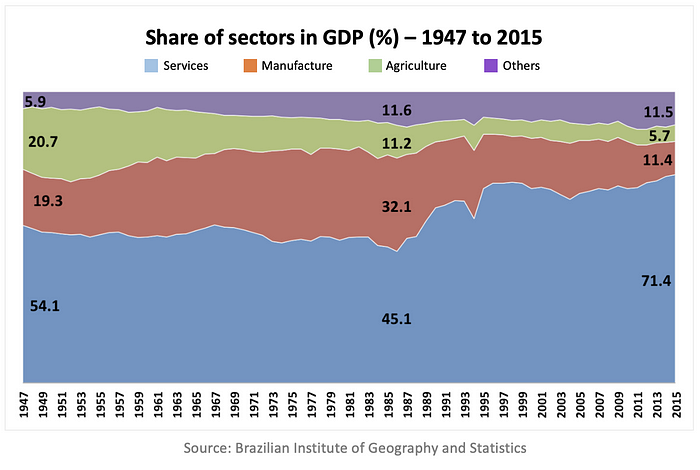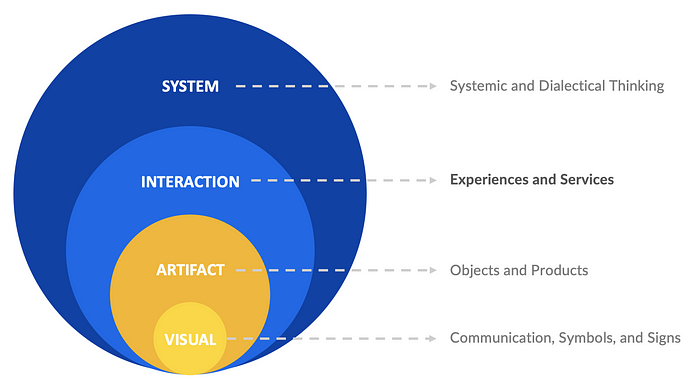We are 20 years into the 21st century already, but it seems that the last century has not yet left us. And I’m not talking about the fashion of always reliving some past decade to launch “aesthetic and artistic reinterpretations”. I’m talking about the fear of the unknown, about the world where we were born and raised, which no longer exists. Uncertainty makes us grab knowledge that has already been tried and tested.
This might be hard for many people, but industrialization is long over. Even the term Industrial Design — the original term for the designer’s profession is no longer used — I use it only when filling in the ‘profession’ field on professional occupation forms. The term Design was incorporated into our lexicon in the last decades of the last century… and today, to say that you are an ‘industrial designer’ is a laughing matter and a telling sign that you are an old person!
Manufacturing has long been considered the basis of economic growth in developed countries, but it is coming to an end. Growth in developed economies will increasingly come from the service segment. Developing economies, as always, take their time to keep up with changes, but they always catch up at some point.
Dave Gray in his book “The Connected Company” presents us with a lot of information about the US market. Here is a thought-provoking quote:
“Since 1960, services have dominated the North American labor market. The current service sector accounts for about 80% of the North American economy. Nine out of ten companies with less than 20 employees are in the service sector.”
The benchmark of industrialization times was its serial manufacturing process and the main result of such a process: the product! According to the Houaiss dictionary of the Portuguese language, “[a] product is what is produced; [the] result of production”. But you must be wondering about the fact that there are still factories here in Brazil and in many other countries, which produce tons and tons of products every year. Indeed, but what sociologists, economists, and historians point out to us is that gears shifted at the turn of the 1960s to the 1970s and the world’s major economies have come to realize the economic power of the service sector. This sector was the greatest source of revenue for developed countries throughout the 20th century and the world has continued to admire the important discoveries of the scientific and technological power of advanced nations. In Brazil, the service sector has always been the most profitable one despite the delayed industrialization process.

Portuguese sociologist Boaventura Santos characterizes the turn from products into services in global economies by discussing 4 core features of the current moment in which we are:
“We live in a post-industrial world, which is consolidated in organizational experience, in investment in cutting-edge technology, in groups of specialists, in modular production, in the generation of services and in the production and transmission of information. We are surrounded by information. [This] Information, when transformed into knowledge, becomes the great capital of humanity in this period. The speed of technological development is changing interpersonal relationships. And globalization that has broken geographical barriers. “
At the same turn of the 1960s to the 1970s, the gears within Design also began to shift. The two traditional branches of the now-defunct ‘Industrial Design’ — i.e, ‘product design and visual communication — were no longer able to address the needs of an ever-changing world. These challenges required us to use design processes within complex contexts to solve tricky problems. In other words, the design had to go from craft mode — from just making design to thinking mode — i.e., thinking about design and its connections with other areas of knowledge. The main advantage of this provocative change is to depart from the material — the world of things — and go to the world of experiences, immaterial and systemic thinking. Understanding this turning point is crucial if we want to understand what is happening in Design these days.
In the last decade of the 20th century, when we were still ecstatic with digital experiments and possibilities, such as the web, a design thinker named Richard Buchanan wrote an article that synthesized all these changes. Buchanan’s 1992 article “Wicked Problems in Design Thinking”, which many mistakenly associate with the “emergence of Design Thinking”, raised a big question about the current moment of the profession and pointed to where we should position ourselves to advance.

Adapted from Richard Buchanan: Wicked Problems in Design Thinking (1992)
The graph above is very simple in its interpretation; the two smaller circles (Visual and Artifact) deal exactly with the two traditional and already known skills of Design — important for the construction of artefacts and the development of visual communication. The great expansion comes from the advent of the digital and the web — which makes it possible for Design to start working with technology-mediated interactions between people and interactions between people and their artefacts as well. It was in this context that the disciplines of Service Design and Interaction Design arose — both acting in the realm of experience, otherwise known in the market as user experience or consumer experience.
According to Service Design Networking — the main professional association in this segment, Service Design is the practice of designing services. The discipline uses a holistic and highly collaborative approach to generate value for both the user and the service provider throughout the lifecycle of a given service. Service Design orchestrates experiences that take place over time and at various points of contact. In practice, service design helps to choreograph the processes, technologies, and interactions that drive service delivery using a human-centred perspective.
A service journey and its various points of contact (websites, apps, bots, artefacts, people, and process scripts add up to different interaction channels)
In light of this, I would like to invite everyone to reflect on why we should stop talking about products and start talking about services. My three main points are these::
- We live in a post-industrial world, which demands new production processes and we are immersed in a service economy. People attribute great value to immaterial things and lived experiences. New processes demand new minds and new knowledge. Uncertainty will be on our side, but we need to lose the fear of taking unexplored roads. Welcome to the Design of the Immaterial, and welcome to the Design of the Invisible.
- This might sound odd, but the product vision in the digital realm still contains an understanding of the finitude in the solution generated. In the digital realm, there is no “finished product”, as with a physical product that leaves the factory and arrives at people’s homes. Digital, in its immaterial essence, is the basis for building many communication channels and contact points to access millions of people around the world. When asking for a product — that is, for its purpose — you are looking for the essence of the service behind it. The product is just an avatar of a service.
- The next great frontier of Design, the one that deals with systemic thinking, will only be accessed when we go through the experience layer. To do that, we need to let go of 20th-century design. Vkhutemas and Bauhaus, the first formal schools of design, are 100 years old (in 2018 and 2019, respectively) and we need to build 21st-century design. Today’s world calls for a new approach. The world asks us to think systemically because the problems we face are not isolated and call for a new way of thinking and acting. According to Donald Schön, systemic thinking requires a new design professional, who reflects on their practice, i.e., it’s all about learning by doing and learning by sharing.
To conclude, I would like to invite you to watch Donald Norman’s video, where he talks about the formation of this new professional for the 21st century.
The article was originally produced and published for the Brazilian project Design 2021, which brought together 97 designers to think about the current moment in Brazilian design and was coordinated by Vítor Guerra.


